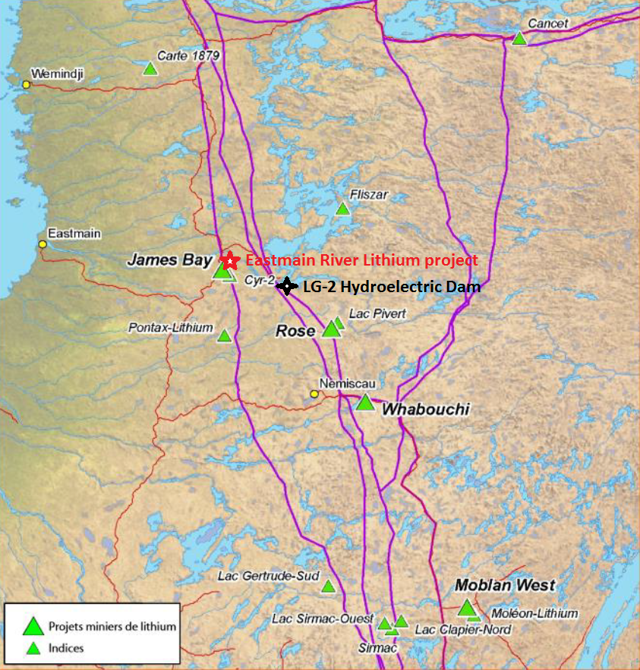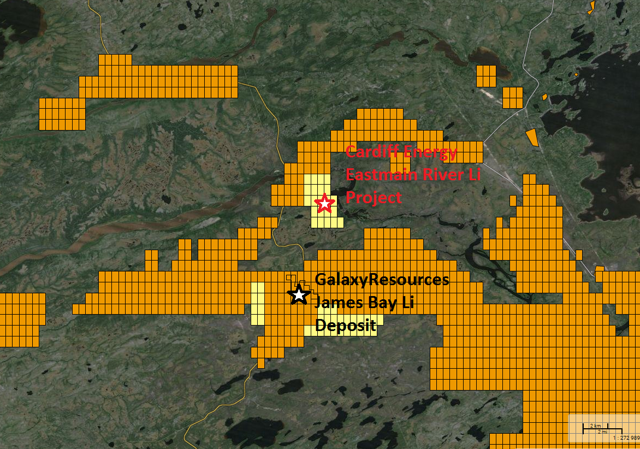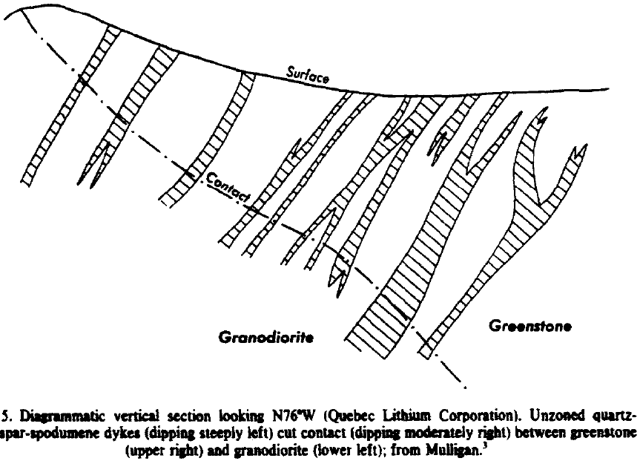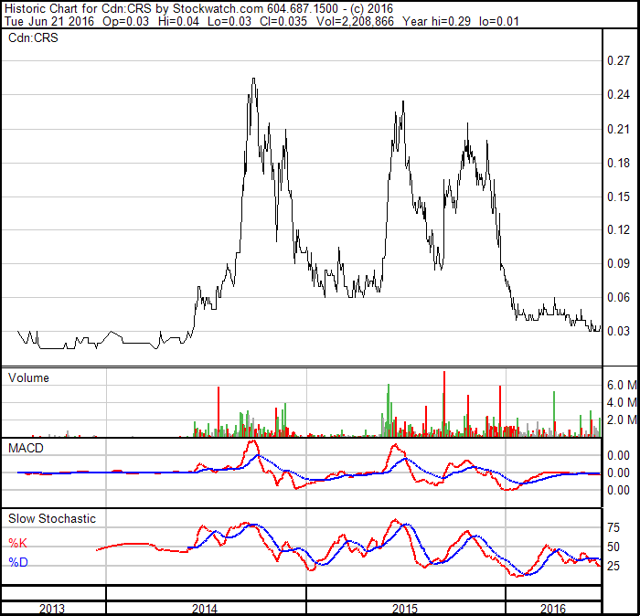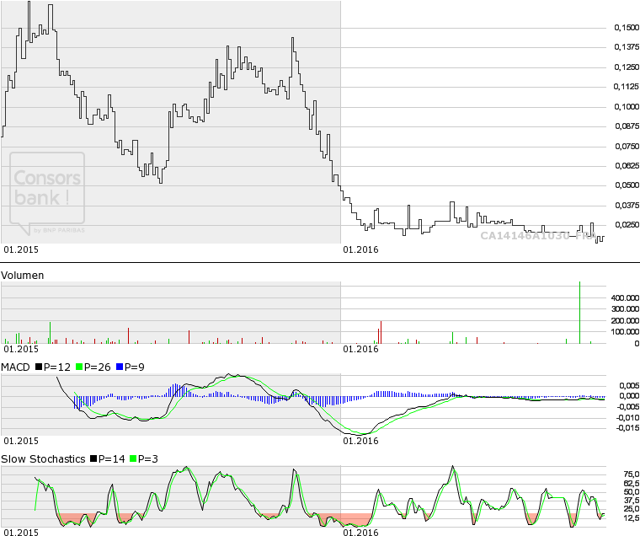Email: sb@rockstone-research.com
(click to enlarge)

Drill core with spodumene lithium mineralization from the James Bay Deposit in Quebec (source: Galaxy Resources Ltd.)Today, Cardiff Energy Corp. (TSX.V: CRS) (OTCPK:CRRDF) announced the acquisition of the Eastmain River Lithium Project in Quebec, just 8 km north of the James Bay Lithium Project from Galaxy Resources Ltd. (OTCPK:GALXF) The Eastmain River area is home to a 4 km zone of irregular cross-cutting dikes of spodumene pegmatites, up to 60 m wide and over 100 m long. As reported by Pelletier in 1977, a total of 277 samples (one third of the outcropping pegmatites) were taken in the Eastmain River area yielding an average historic grade of 1.7% Li2O (Galaxy’s current indicated resource hosts 12 million t grading 1.3% Li2O). No drilling has been done on Cardiff’s property to date, despite extraordinary outcrop exposure in the area with pegmatites cross-cutting at surface. The pegamatites in the Eastmain River area are almost always spodumene bearing and enriched in light elements such as lithium, beryllium, sodium, and boron. Some crystals exceed one meter in length. Slow cooling crystallization of magmatic fluids is the cause for the megacrystic nature of the pegmatites, which makes this area one of the most prospective lithium grounds in all of Canada.
The Eastmain River Lithium Property is located in a region of Quebec that boasts several significant lithium deposits and high-grade spodumene pegmatites. Cardiff’s Eastmain River Property is located in an established lithium district that has been gaining momentum in exploration and development recently, hand in hand with increased investors’ interest.
Property Size: 1,157 hectares (22 claims)
Location & Access: Near kilometer 386 on the road from Matagami, Quebec. The property is easily accessed by a paved highway 2.5 km away or by air from the Opinaca Airport 30 km away.
Power & Infrastructure: The LG-2 hydroelectric reservoir is 31 km to the east. There is a gas station, accommodations, and helicopter support located 8 km to the south west.
Historic exploration: According to J. Terrence Flanagan in “Lithium Deposits and Potential of Quebec and Atlantic Provinces, Canada” (1977): “Eastmain River Deposit: Approximately twenty dikes of spodumene pegmatite occur near kilometer 384 on the road from Matagami, Quebec, to the LG-2 hydroelectric power site. These intrude mainly biotite schists of the Eastmain River greenstone belt. The deposits are mostly irregular cross-cutting dikes or lenses up to 60 m wide and over 100 m long, within a zone about 4 km long by 300 m wide. 277 samples, representing about one-third of the outcropping pegmatites, had an average Li2O content of 1.7%. The total area of outcropping spodumene pegmatite delineated to date is 45,000 m2, equivalent to 121,000 tonnes per vertical meter without allowing for extrapolation between outcrops. No drilling has yet been done these deposits, so their vertical extent is not known (Pelletier).”
Geology & Mineralization: The Eastmain River Li Project is situated in the lower Eastmain greenstone belt, part of the northeastern portion of the superior province. Rock types mainly consist of amphibolite facies, felsic metavolcanics and metasedimentary rocks. Outcrop exposure is extraordinary in the area with pegmatites crosscutting at surface. The pegamatites of the Eastmain River area are almost always spodumene bearing and enriched in light elements such as lithium, berryllium, sodium and boron. Some crystals exceed 1 m in length (slow cooling crystallization of magmatic fluids is the cause for the megacrystic nature of the pegmatites).
Other Lithium Projects in the James Bay area of QuebecThe James Bay Lithium Project (Galaxy Resources Ltd.; $673 million AUD market capitalization) is located 8 km to the south of Cardiff’s property, occurs at surface and resource modelling indicates that the resource is amenable to open pit extraction. According to Galaxy, there is excellent potential to increase the resources through additional delineation of the pegmatite dikes along strike and at depth and potential to increase grade through infill drilling. Lithium mineralisation at James Bay is associated with spodumene-bearing pegmatite dike swarms, which vary in width from 60-100 m. The dikes generally outcrop at surface, and form a dis-continuous corridor over a strike length of 4 km. Almost all the pegmatites at James Bay are known to be spodumene-bearing, with relatively coarse crystals (usually more than 5 cm, sometimes exceeding 1 m). The coarse grained spodumene mineralisation is likely to respond very well to conventional processing.
Indicated: 11.75 million t @ 1.3% Li2O
Inferred: 10.47 million t @ 1.2% Li2O
The Whabouchi Deposit (Nemaska Lithium Inc.; (OTCQX:NMKEF) $342 million CAD market capitalization) has a feasibility study for the deposit and a hydromet plant, revised in January 2016:
Measured: 13 million t @ 1.6% Li2O
Indicated: 15 million t @ 1.54% Li2O
Inferred: 4.7 million t @ 1.51% Li2O
The Rose Lithium-Tantalum Deposit (Critical Elements Corp.; (OTCQX:CRECF) $82 million CAD market capitalization):
Indicated: 26.5 million t @ 1.3% Li2O
Inferred: 10.7 million t @ 1.14% Li2O
According to J. Terrence Flanagan in “Lithium Deposits and Potential of Quebec and Atlantic Provinces, Canada” (1977):
“Quebec was an important lithium producer from 1955 to 1965 and could regain this status when adequate markets are available. Most of the known lithium deposits are spodumene-bearing pegmatites in the Superior structural province of the Canadian Precambrian Shield. Although very little systematic exploration has been carried out, spodumene dikes have been found in every major greenstone belt between latitudes 47 and 53N. They usually occur near the upper contacts between late-stage granitic intrusive masses and metamorphosed volcanic and sedimentary rocks, and appear to represent a normal stage in the metallogenic evolution of this area.
The potential of the known Quebec deposits and their possible extensions laterally and at depth is amost 1 million tonnes of contained lithium. Several recent discoveries, made while prospecting for other minerals, support the view that many additional deposits remain to be found. These can contribute substantially to the assurance of an adequate supply to support the energy options which depend on lithium.
Known lithium deposits in Eastern Canada are all of the pegmatite type. Quebec was an important producer of spodumene concentrate from 1955 to 1959 and of lithium carbonate and hydroxide from 1960 to 1965, both from the Quebec Lithium Corporation property in Lacorne Township. There has been no lithium production in Quebec since 1965 but numerous lithium-bearing pegmatites have been identified; many of these are still undeveloped.”
Company DetailsCardiff Energy Corp.
3920 Delbrook Avenue
North Vancouver, BC, Canada V7N 3Z8
Phone: +1 604 505 4380
Email: info@cardiffenergy.com
www.cardiffenergy.com
Shares Issued & Outstanding: 65,959,611
Canadian Symbol (TSX.V): CRS
Current Price: $0.04 CAD (June 21, 2016)
Market capitalization: $3 million CAD
German Symbol / WKN (Frankfurt): C2Z / A119FM
Current Price: €0.018 EUR (June 21, 2016)
Market capitalization: €1 million EUR
Please read the entire Disclaimer carefully. If you do not agree to all of the Disclaimer, do not access this website or any of its pages including this report in form of a PDF. By using this website and/or report, and whether or not you actually read the Disclaimer, you are deemed to have accepted it. Information provided herein is educational and general in nature.
Disclaimer © 2010 Junior Gold Report
Junior Gold Report’ Newsletter: Junior Gold Report’s Newsletter is published as a copyright publication of Junior Gold Report (JGR). No Guarantee as to Content: Although JGR attempts to research thoroughly and present information based on sources we believe to be reliable, there are no guarantees as to the accuracy or completeness of the information contained herein. Any statements expressed are subject to change without notice. JGR, its associates, authors, and affiliates are not responsible for errors or omissions.
Forward Looking Statements
Except for statements of historical fact, certain information contained herein constitutes forward-looking statements. Forward looking statements are usually identified by our use of certain terminology, including “will”, “believes”, “may”, “expects”, “should”, “seeks”, “anticipates”, “has potential to”, or “intends’ or by discussions of strategy, forward looking numbers or intentions. Such forward-looking statements involve known and unknown risks, uncertainties and other factors which may cause our actual results or achievements to be materially different from any future results or achievements expressed or implied by such forward-looking statements. Forward-looking statements are statements that are not historical facts, and include but are not limited to, estimates and their underlying assumptions; statements regarding plans, objectives and expectations with respect to the effectiveness of the Company’s business model; future operations, products and services; the impact of regulatory initiatives on the Company’s operations; the size of and opportunities related to the market for the Company’s products; general industry and macroeconomic growth rates; expectations related to possible joint and/or strategic ventures and statements regarding future performance. Junior Gold Report does not take responsibility for accuracy of forward looking statements and advises the reader to perform own due diligence on forward looking numbers or statements.


